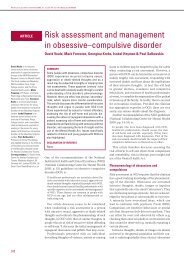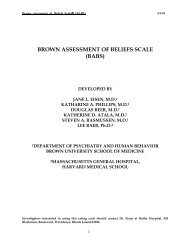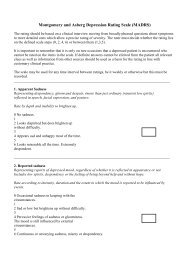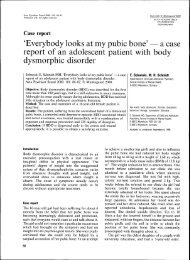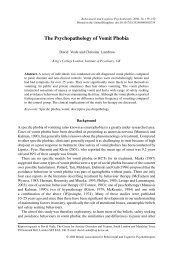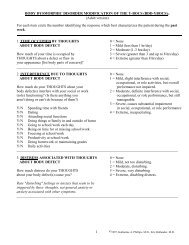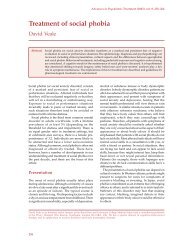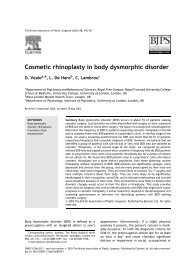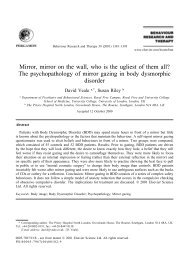Cognitive behaviour therapy for a specific phobia of vomiting
Cognitive behaviour therapy for a specific phobia of vomiting
Cognitive behaviour therapy for a specific phobia of vomiting
Create successful ePaper yourself
Turn your PDF publications into a flip-book with our unique Google optimized e-Paper software.
286 D. VealeDropping safety <strong>behaviour</strong>sSafety-seeking <strong>behaviour</strong>s will interfere in exposure and are the main obstacle to progress. Thegoal is to drop all the responses that are believed to maintain the fear. This includes cognitiveprocesses such as worry and attentional biases towards potential risks. If you identified themeta-cognitions about the cognitive processes (e.g. ‘It can help me mentally prepare myself <strong>for</strong><strong>vomiting</strong>’), then these can usually be challenged pragmatically on the basis <strong>of</strong> their unintendedconsequences and their costs (e.g. ‘How effective is worry at mentally preparing yourself?Is this something you would teach others? If not, why not?; What is the cost <strong>of</strong> mentalplanning?’).Dropping <strong>of</strong> safety-seeking <strong>behaviour</strong>s and self-focused attention may be assisted by<strong>behaviour</strong>al experiments in which the <strong>behaviour</strong> is either increased or decreased and asking theclient to make <strong>specific</strong> predictions. Does the use <strong>of</strong> a safety-seeking <strong>behaviour</strong> or compulsionincrease or decrease her worry and distress about <strong>vomiting</strong>? Does focusing her attentioninternally and monitoring the level <strong>of</strong> nausea increase distress compared to focusing externally?A similar approach can be used <strong>for</strong> compulsions. Some clients excessively check the freshness<strong>of</strong> food, have abnormal hygiene measures, check excessively health <strong>of</strong> themselves and others,follow superstitious <strong>behaviour</strong>s, repeatedly seek reassurance, per<strong>for</strong>m excessive cleaning <strong>of</strong>kitchen area and toilet. Compulsions are identified and can be added to the hierarchy <strong>for</strong>them to be discontinued. Similar to people with OCD, it is usually important to identifythe termination criteria <strong>for</strong> a compulsion (e.g. feeling com<strong>for</strong>table) that are problematic inmaintaining the <strong>behaviour</strong> and to ensure that if a compulsion is conducted, then the patient‘undoes’ it by re-exposing herself to the original risk.For fears <strong>of</strong> negative evaluation by others about <strong>vomiting</strong>, the therapist may suggest theirclient conducts a survey <strong>of</strong> attitudes towards someone else <strong>vomiting</strong> who is ill. The clientshould make her predictions first and then ask others how repulsive they would find someoneelse <strong>vomiting</strong>, or <strong>for</strong> how long they would be repulsed, or the degree to which a person wouldmake a fool <strong>of</strong> themselves. A therapist may role-play <strong>vomiting</strong> with fake vomit and take asurvey <strong>of</strong> people passing.Pharmaco<strong>therapy</strong>There is no evidence base <strong>for</strong> the use <strong>of</strong> pharmaco<strong>therapy</strong> in <strong>specific</strong> <strong>phobia</strong>s, but there mightbe a rationale <strong>for</strong> a selective serotonin reuptake inhibitor (SSRI) in those with severe symptomsthat overlap with OCD and who are unresponsive to CBT. Nausea is a potential side-effect <strong>of</strong>a SSRI which might be used as a <strong>for</strong>m <strong>of</strong> exposure or may mean that it is an unacceptableapproach.AcknowledgementsI acknowledge the helpful discussions with the team at the national service <strong>for</strong> Specific Phobia<strong>for</strong> Vomiting at the Bethlem Royal Hospital: Simon Darnley, Linda Atkinson, Debbie Cranston,Helen Joceyln-Gadd, Nicholas Page, Angelika Tompkinson and Nell Ellison, and at The PrioryHospital North London: Michelle Diskin, Dolores Glancy and Rob Willson, and discussionswith Katy Price <strong>of</strong> University College London and Mark Boschen <strong>of</strong> Griffith University,Brisbane. I also acknowledge support from the National Institute <strong>for</strong> Health Research (NIHR)



